![]()
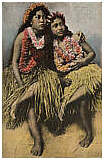 I think that the 4-string tenor ukulele is probably one of the best instruments that I make. It’s also one of my favorites to listen to, so I wanted to spend a little time talking about several ways that the instrument can be tuned.
I think that the 4-string tenor ukulele is probably one of the best instruments that I make. It’s also one of my favorites to listen to, so I wanted to spend a little time talking about several ways that the instrument can be tuned.
These days, at least in Hawaii, the most common tuning for the 4-string tenor is G(4th), C(3rd), E(2nd), A(1st). Historically, this is called the “C” tuning, perhaps because C was the lowest note in the soprano tuning. Let’s first get you up to speed with the tenor tuning and then discuss two other tunings after that.
I use Savarez Alliance standard tensions (red card) for my soprano, concert and tenor treble strings : 541R for the A, 542R for the E and 543R for the C. I use D’Addario Pro Arte SP Light D strings (YB-J4304) for both the low G and low A bass strings.
Unlike the soprano (also called standard) and concert sized ukuleles, the G in the GCEA tuning for the tenor is lower than the C note. Here is a sound file of the open G string:
Play the file and adjust the fourth string (usually a silver colored one) so that it sounds the same to you. Alternatively if you have a soprano ukulele pitch pipe with gCEA notes on it, press the fourth string down at the 12th fret and tune the string so that it’s the same as the g on the pitch pipe.
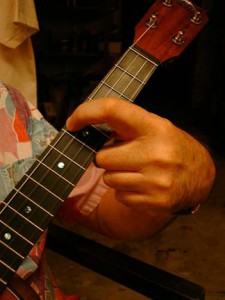 Now that we have the open G string tuned, let’s move on to the C string adjacent to it. In this first photo we see the carefully placed finger of my good friend Kimo Gerald resting on the fifth fret of the fourth string. This fretted note will be middle C if we have tuned the open string correctly. The sound file Ctune.wav will give both the fretted note (first) and the open C string (second) for comparison. You can also use the soprano pitch pipe C note for this string.
Now that we have the open G string tuned, let’s move on to the C string adjacent to it. In this first photo we see the carefully placed finger of my good friend Kimo Gerald resting on the fifth fret of the fourth string. This fretted note will be middle C if we have tuned the open string correctly. The sound file Ctune.wav will give both the fretted note (first) and the open C string (second) for comparison. You can also use the soprano pitch pipe C note for this string.
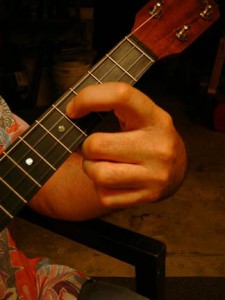 Now that we have the open C string tuned, let’s move on to the E string adjacent to it. In this second photo we again see Kimo’s carefully placed finger of resting on the fourth fret of the third string. This fretted note will be E above middle C. The sound file Etune.wav will give both the fretted note and the open E string for comparison. You can also use the soprano pitch pipe E note for this string.
Now that we have the open C string tuned, let’s move on to the E string adjacent to it. In this second photo we again see Kimo’s carefully placed finger of resting on the fourth fret of the third string. This fretted note will be E above middle C. The sound file Etune.wav will give both the fretted note and the open E string for comparison. You can also use the soprano pitch pipe E note for this string.
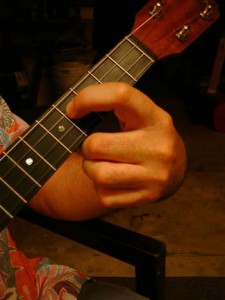 Now that we have the open E string tuned, let’s move on to the A string adjacent to it. In this third photo we again see Kimo’s carefully placed finger of resting on the fifth fret of the second string. This fretted note will be A above middle C. The sound file Atune.wav will give both the fretted note and the open A string for comparison. You can also use the soprano pitch pipe A note for this string.
Now that we have the open E string tuned, let’s move on to the A string adjacent to it. In this third photo we again see Kimo’s carefully placed finger of resting on the fifth fret of the second string. This fretted note will be A above middle C. The sound file Atune.wav will give both the fretted note and the open A string for comparison. You can also use the soprano pitch pipe A note for this string.
The nice thing about the GCEA tuning is that lots of chord music for the ukulele is written with this tuning in mind. In principle, it would also be possible to tune the G note above C and drop the A note an octave. The chording would be the same but low G and G# wouldn’t be available for playing and fingerstyle work might be somewhat more difficult…
Interestingly enough, if you put a capo or bar across the fifth fret of the guitar the first four strings have the notes GCEA just like the tenor ukulele tuning described above. Well, what if you have always played guitar and are new to the ukulele? Since the GCEA tuning is just a higher frequency of the same note relationships, why can’t we tune the tenor ukulele like a guitar, that is DGBE? We can, and such a tuning was very popular in the 1940’s and 1950’s and is used by the famous ukulele player Lyle Ritz on his albums. For the tenor, however, it is usual to have the D note be higher than the G note analogously to soprano ukulele tuning. So the G note is the lowest note in this tuning just as it was in the “C” tuning.
For this tuning I suggest a mix of Savarez Alliance standard (red card-R) and high tensions (blue card-J) for the tenor treble strings : 542R for the E (as above), 543R for the B and 543J for the D. Use D’Addario Pro Arte SP Light D strings (YB-J4304) for the low G bass string.
Here are the sound files for D above G ( Dtune.wav ); open G ( openGtune.wav ); B above G ( Btune.wav ); and E above G ( Etune.wav ).
Table 1 below shows the notes and frequencies of each note for the two tunings mentioned thus far, and the “D” tuning as well.
| Table 1. Common Tenor Ukulele Tunings | ||||
|---|---|---|---|---|
|
“C” tuning |
“G” Tuning |
“D” tuning |
||
| First Course | A (440 Hz) | E (329.6 Hz) | B (493.9 Hz) | |
| Second Course | E (329.6 Hz) | B (246.9 Hz) | F# (370 Hz) | |
| Third Course | C (261.6 Hz) | G (192 Hz) | D (293.7 Hz) | |
| Fourth Course | G (196 Hz) | D (293.7 Hz) | A (220 Hz) | |
But if all we have are music instruction manuals in GCEA tuning, how can we use our dGBE tuning and get the right chords? Table 2 below shows how to go about it. What if we want to play a G chord in the “G” tuning but only know the “C” tuning chord positions? Looking above the letter G in the “G” tuning row, we see that we need to finger the C chord the way we learned it in “C” to get a G chord in G tuning. Of course guitar players already know all the “G” tuning chords and just have to get used to not having two bass strings to play on.
| Table 2. Changing from one tuning/key to another | ||||||||||||
|---|---|---|---|---|---|---|---|---|---|---|---|---|
| “C” tuning | A | A# | B | C | C# | D | D# | E | F | F# | G | G# |
| “G” tuning | E | F | F# | G | G# | A | A# | B | C | C# | D | D# |
| “D” tuning | B | C | C# | D | D# | E | F | F# | G | G# | A | A# |
But why should we be interested in the “D” tuning? It sometimes happens that the air resonance of the body will coincide with one of the lowest frequency notes, making it sound more “thunky” or percussive than the other notes. In my tenors, the air resonance is usually near low G#. This is shown for two tenors in the somewhat gaudy presentation below. The graph is a display of peak amplitude versus frequency. I generated the graph using the program SpectraPLUS. Each instrument was tapped at the bridge center and the tap deconvolved into its respective frequencies using an FFT routine within SpectraPLUS. The two peaks just to the right of the vertical 200 Hz line represent the air resonances for two of my 4-string tenors. The red peak value is 211 Hz and the black peak value is 214 Hz. Curves further to the right represent the first fundamentals of the top and back and perhaps a second fundamental of the top. More regarding those at another time.
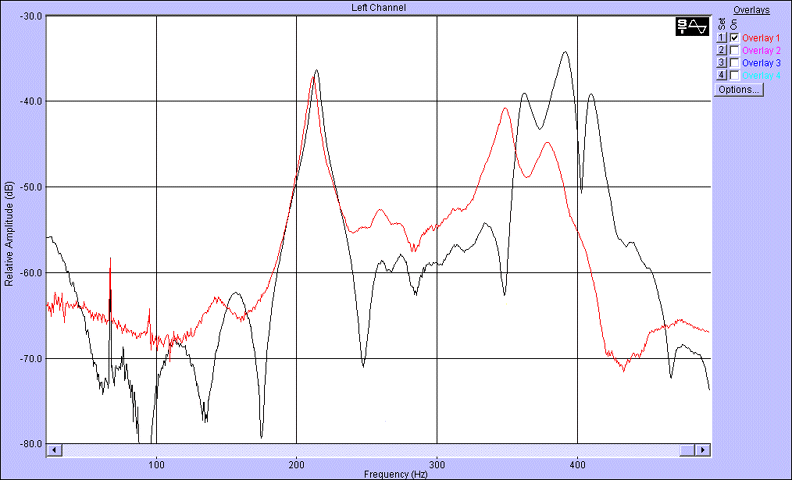 |
By raising the tuning from “C” tuning to “D” tuning, none of the low notes coincide with the air resonance and the “thunkiness” is reduced. As shown in Table 2, all of the chords remain analogous but are now in different keys. So playing the “C” tuning position for a C chord will now make a D chord in the “D” tuning. Of course it’s also possible to change the low G note to a high G so as to still play the “C” tuning, but then you’ve turned the tenor ukulele into a concert with none of the lovely low notes that the tenor should have.
For this tuning use Savarez Alliance standard tensions (red card) for the tenor treble strings : 541R for the B, 542R for the F# and 543R for the D. Again, use D’Addario Pro Arte SP Light D strings (YB-J4304) for the low A bass string.
Table 3 is added for user interest and convenience, giving the two octave range of frequencies for the most commonly played notes on the tenor ukulele.
| Table 3. Frequencies of a two octave range of tenor ukulele notes | |||||||||||||
|---|---|---|---|---|---|---|---|---|---|---|---|---|---|
| Note | G | G# | A | A# | B | C | C# | D | D# | E | F | F# | G |
| freq, Hz | 196 | 207.7 | 220 | 233.1 | 246.9 | 261.6 | 277.2 | 293.7 | 311.1 | 329.6 | 349.2 | 370 | 392 |
| freq, Hz | 392 | 415.3 | 440 | 466.2 | 493.9 | 523.5 | 554.3 | 587.3 | 622.2 | 659.3 | 698.5 | 740 | 784 |
If you enjoy the technical side of things, please consider buying my book “Left-Brain Lutherie” .
I enjoy writing these pages and hope that they are interesting and useful to the reader. I’ve stopped weaving/building at this time and still need to generate some income in order to continue to expand this website with more useful articles. If this page was helpful to you and you would like to make a $10.00 donation in order to have more pages like it, please use the donation button below. Thank you.